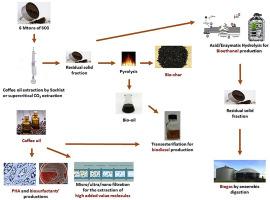Renewable and Sustainable Energy Reviews ( IF 16.3 ) Pub Date : 2020-07-09 , DOI: 10.1016/j.rser.2020.110007 Federico Battista , Elli Maria Barampouti , Sofia Mai , David Bolzonella , Dimitris Malamis , Konstantinos Moustakas , Maria Loizidou

|
Spent Coffee Grounds worldwide production is estimated at around 6 M tons only at industrial level. The abundance and the heterogeneity of this substrate make it an ideal substrate for a biorefinery approach based on the “cascade biorefinery hierarchy”. Currently, the major part of spent coffee grounds is sent to incineration and landfill disposal, options which should be avoided. Instead, they could be valorised through biofuels production. All the operational parameters leading to the highest biogas (350-400LCH4/kgTVS), bioethanol (3–4%v/v) and biodiesel (over 90% of Fatty Acid Methyl Esters concentration) yields from spent coffee grounds have been discussed in this review paper. They are rich in an oil phase containing different added-value molecules (tocopherols, cafestol, kahweol along with linoleic and palmitic acids), which can be extracted and used as additives for food, cosmetic and pharmaceutical applications. Solid/liquid extraction techniques of coffee oil from spent coffee grounds such as the most common Soxhlet technique and the more innovative fluids in supercritical conditions have been discussed, with coffee oil recovery of around 5–15%w/w and 15–20%w/w, respectively. The most recent applications of the extracted coffee oil have been also presented: the added-value molecules recovery and purification after micro/ultra and nano filtrations processes and the polyhydroxyalkanoates (0.84 g/g) and biosurfactants (3.5 g/L) production. Considering the whole information, an integrated biorefinery scheme, along with the respective mass balances were proposed. The novelty of this paper lies in the integration of the state-of-the-art data, in a biorefinery concept that would allow the production of both biofuels and value-added products.
中文翻译:

从废咖啡渣中回收增值分子并生产生物燃料
仅在工业水平上,全世界的废咖啡渣产量估计约为600万吨。这种基质的丰富性和异质性使其成为基于“级联生物精炼厂层次结构”的生物精炼方法的理想基质。目前,用过的咖啡渣的大部分被送到焚化炉和垃圾掩埋场处理,应避免这种选择。相反,可以通过生物燃料生产来增值它们。所有可产生最高沼气的操作参数(350-400L CH4 / kg TVS),本文讨论了废咖啡渣的生物乙醇(3-4%v / v)和生物柴油(脂肪酸甲酯含量超过90%)的产量。它们富含油相,其中包含不同的增值分子(生育酚,咖啡酚,kahweol以及亚油酸和棕榈酸),可以将其提取并用作食品,化妆品和制药应用的添加剂。已经讨论了从废咖啡渣中提取咖啡油的固/液技术,例如最常见的索氏萃取技术和在超临界条件下更具创新性的液体,其中咖啡油的回收率约为5-15%w / w和15-20%w / w。还介绍了提取咖啡油的最新应用:微/超滤和纳滤过程以及多羟基链烷酸酯(0.84 g / g)和生物表面活性剂(3.5 g / L)生产后,附加值分子的回收和纯化。考虑到整个信息,提出了一个综合的生物精炼方案,以及各自的质量平衡。本文的新颖之处在于将最新数据整合到生物精炼厂概念中,从而可以生产生物燃料和增值产品。











































 京公网安备 11010802027423号
京公网安备 11010802027423号